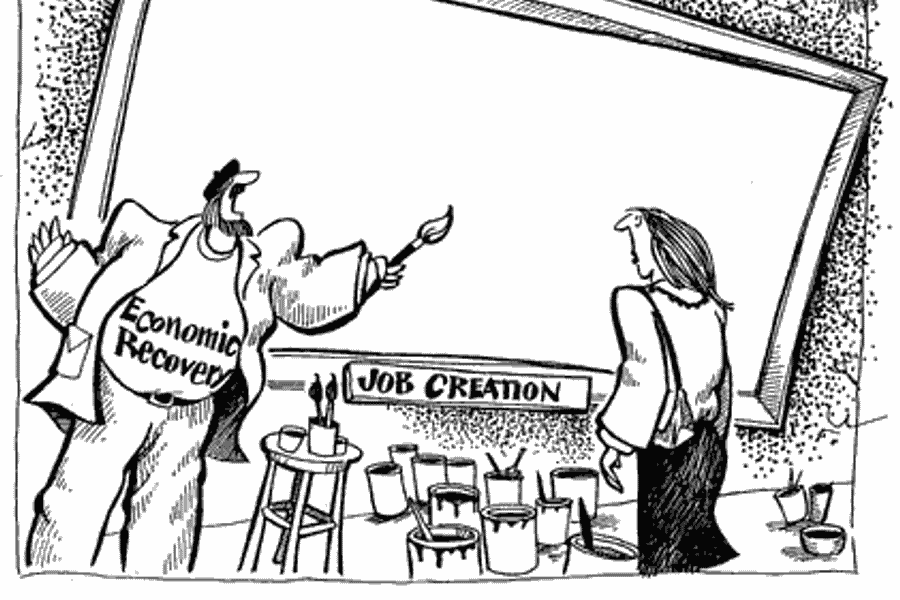
While the recession has left no community untouched, we’re not all feeling the same pain. From the outset, people of color started out lower, fell farther, and landed harder, according to a new report from the Center for American Progress.
While joblessness has dragged down all workers, in good times and bad, whites fare better than people of color. Blacks have historically suffered extremely high unemployment rates, followed by Latinos.
And while Latinos have done relatively well in the labor market in recent years, CAP reports, “since the current crisis started in the construction sector, Hispanics have quickly lost ground and their labor market experience once again resembles that of African Americans.”
The analysis found similar racial disparities in income, homeownership, health insurance coverage, and retirement resources. Among lower-skilled workers, even those with similar backgrounds, Blacks consistently earn less than whites.
People of color are also especially vulnerable to economic calamities like predatory lending, which undermine entire neighborhoods and impede social mobility across generations.
On balance, the authors conclude, “the recession has heightened losses and widened gaps between minorities and whites.”
The trends in health coverage reveal how racial disparities reflect and perpetuate other inequities. Although insurance coverage appears to have grown for Latinos between 2000 and 2007 (in contrast with declines among blacks and whites), the researchers found that
What seems at first like good news for Hispanics turns out to be bad news in disguise. Health insurance coverage through an employer dropped for Hispanics, just as it did for whites and African Americans.
The gains in health insurance for Latinos are probably a byproduct of lower income levels, which means more Latinos qualify for Medicaid. That finding underscores the crucial role of government-sponsored healthcare, but at a time when states are shredding their social safety nets, the volatility of employer-based insurance foreshadows a deepening crisis.
The reform proposal floated by Sen. Max Baucus could erode health security for low-income families by saddling them with unsustainable insurance costs and inadequate subsidies.
With different communities weathering the crisis on an uneven keel, CAP fellow Christian Weller argued in recent congressional testimony that the rising-tide-lifts-all-boats rationale is dangerously shortsighted:
Concrete policy steps must be taken to make sure that the U.S. economy can finally erase the gulf in economic security and economic opportunities between whites and minorities. These concrete steps start with the continuation of a substantial economic stimulus to get the U.S. economy out of its worst recession since the Great Depression, but they also require energy security and health care reform.
The crisis of inequality has been repeatedly voiced to lawmakers for years, from boom times right up to the current bust.
Yet a peculiar deafness persists in the political establishment. In a commentary on black poverty, Algernon Austin, director of the Race, Ethnicity, and the Economy program at the Economic Policy Institute, wrote that “the United States has such a high poverty rate because we choose to.”
Noting that America seems to tolerate abysmal income gaps that are unheard of in other wealthy nations, Austin said, “All of these countries have a stronger commitment to reducing poverty through progressive taxation. We could do better, but we don’t.”
The Recovery Act could be an opportunity to rebuild the economy on a more equal plane, but only if the public can hold officials accountable for confronting inequity. The Kirwan Institute and other groups have launched fairrecovery.org to monitor where the stimulus is going.
So far, a handful of states have made strides toward the rigorous reporting standards recommended by advocates. In Maryland, for instance, the state’s recovery website enables the public to map the geographic distribution of job development funds according to local unemployment rates, or school funding distribution according to the education levels of local residents.
If activists apply a comprehensive equity-based analysis to the stimulus spending, they could lay out a long-term framework for pushing governments to take responsibility for racial and economic gaps.
Now that the economic crisis has made it nearly impossible to ignore the demographic contours of inequality, the next step is to wield that knowledge to ensure that recovery means not just restoring privilege to those who’ve slipped, but lifting up those who’ve always been down.
Michelle Chen is a contributing writer at In These Times and The Nation, a contributing editor at Dissent and a co-producer of the “Belabored” podcast. She studies history at the CUNY Graduate Center. She tweets at @meeshellchen.








